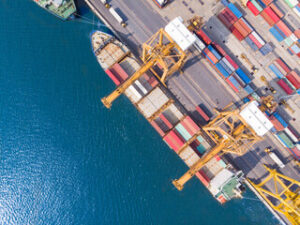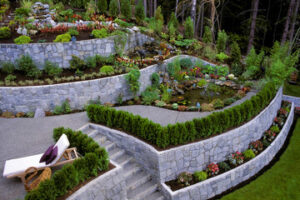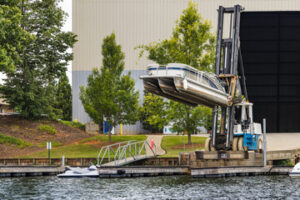Many docks are built from wood, which offers a visual impact and blends in well with the surrounding environment. It’s also a cost-effective option, especially when treated to resist rot and pests.

Steel pilings are ideal for commercial and industrial docks for their durability and stability. They’re also easily installed using blind bolts. Keep reading the article below to Learn More.
Many factors play into the design of a dock, including the specific water body, its surrounding terrain, and other environmental conditions. During the planning process, it’s crucial to take into account wind patterns and water levels, as well as the unique characteristics of the lake bottom and shore geology. These elements will determine the structure’s durability and stability and should be factored into the final plan.
When choosing the materials to use for a dock, it’s important to consider functionality as well as cost and maintenance capacity. Wood, steel and aluminum are all durable and popular choices, but each has its own set of pros and cons. Wood requires more upkeep, as the structure must be treated and sanded regularly to keep it from rotting or splintering. Metal, on the other hand, is less expensive and offers the same level of durability as wood. Additionally, most metal docks can be made to withstand harsh weather conditions and high tidal currents.
Another factor to consider is the type of activity you wish to carry out on your dock. For example, if your dock will be used for recreation, it’s important to include multiple entertainment options so that the camaraderie doesn’t have to end when the sun goes down. Incorporating a number of seating and lounge areas, as well as adequate lighting to illuminate the area, will ensure that guests can continue to enjoy the space long after sunset.
Loading docks must also consider safety features as they’re often the main entry point for trucks and their cargo. To prevent accidents, it’s essential to implement a system of signals that indicate when loading is in progress and when the operation has been completed. It’s also crucial to have a wheel chock available in case of any accidental movements during transport.
It’s also important to decide whether you want your dock to be permanent or removable. Permanent docks don’t require any work each fall and spring to be removed and lowered back into the water, but they can be affected by harsh winters and heavy ice build-up. Removable docks, on the other hand, can be lifted from the water using a tower system that attaches to the shoreline support posts.
Materials
When choosing the materials to use in dock construction it is important to consider a number of things. Firstly, the material will need to be sturdy enough to support heavy loads and withstand wavy conditions, as well as being able to resist the impact of the marine environment. It is also a good idea to choose a material that is resistant to rust and corrosion and does not require constant maintenance. It is usually best to opt for high-quality materials which may cost a little more upfront but are more durable in the long run.
The type of wood used in the construction of a dock can be an important factor in its final durability. Douglas fir is an ideal wood for dock beams because of its strength and resistance to impact. It also has a very good water resistance and can be used in both freshwater and saltwater environments.
Another popular choice for a dock’s piling is concrete. While it does not have the same aesthetic appeal as wood, concrete is resistant to rot and can be reinforced with steel for increased tensile strength. It is also a great choice for marine environments because it is not toxic to marine life.
Metal pilings are generally the strongest and sturdiest of the materials available for dock construction. They are commonly fastened using blind bolts and can withstand the most challenging marine environments. However, they can have higher upfront costs and a more specialized installation process.
Man-made materials such as fiberglass are another option for dock pilings. These have a lower initial investment than natural wood but can last for decades and are more resistant to rot, rust and roosting pests than natural wood.
Another thing to keep in mind when choosing the material for a dock is its location. For example, if the dock is going to be used for commercial purposes it needs to be able to support large ships and containers, which means that the pilings must be very strong. Lastly, a dock will need to be properly anchored to ensure that it does not spin around in windy or wavy conditions.
Permits
Depending on the location and rules of your neighborhood, homeowner association or even state and local policies, you may need to obtain a permit for any work related to dock construction. Some states require that all docks be built from certain materials, while others may require that the structure be inspected by a professional to ensure it meets safety and structural requirements. In some cases, the process to get a permit can be lengthy and costly, so it’s important to research the policy requirements in your area before starting any building or renovation projects.
For example, in Truesdale Lake, any new dock or modification of existing docks must be approved by the dock committee. This committee is composed of members from the TLPOA, TEA and Lake Shore Drive unaffiliated riparian homeowners association. The committee also reviews each application to ensure it follows the town’s wetland buffer laws, and any construction work must be done by a licensed professional.
Some docks require a special permit, which is usually accompanied by specific design and placement guidelines that aim to reduce crowding and overcrowding, protect the natural environment and promote safety and accessibility for users. The committee will also determine the number of docks allowed on a given section of the lakeshore, and the maximum size of individual docks. The committee will review each permit and may request a site visit prior to making a decision.
Other structures, like moorings and wharves, must be registered annually and will generally need to be constructed or modified under a permit. These structures may qualify for a GP 19 permit, which permits construction of a dock or pier in a freshwater wetland, wetland transition area or State open water, or for an Individual Permit.
All professionals and contractors performing marine construction work or working over water must provide proof of US Longshoreman’s and Harbor Workers insurance coverage before a permit can be issued. Some professionals may also need to demonstrate that they have a contractor’s license for the scope of work they intend to perform. The fee for a permit will vary from place to place, but it will likely be determined on a case-by-case basis.
Installation
A dock is not as complicated a structure as it may seem at first glance, but there are a few things to keep in mind when building one. First, you’ll want to make sure the pilings are securely anchored in the bottom of your pond or lake. This requires digging a hole or setting them in concrete footers—depending on the soil type.
Secondly, you’ll want to make sure your dock is able to rise and fall with fluctuations in water levels. For this reason, it is often best to use a modular dock system that consists of a shore platform and a floating pontoon section. NyDock’s proprietary Pipefusion HDPE pontoons are the perfect choice for this type of system as they have been designed and tested to withstand extreme loads and tidal changes.
Finally, it is important to consider how the dock will be used and plan accordingly. For example, if you plan on having several people using your dock at the same time, you should build seating directly into the design of the structure. This eliminates the need to purchase and install additional furniture, which can be expensive and quick to wear out in a waterfront setting.
If you’re building a traditional dock, you’ll also want to make sure that the structure is designed to support your boat. This can be done by installing a heavy-duty anchoring system or adding extra support beams.
In addition, you should always keep in mind that your dock will likely be exposed to the elements, including the sun and wind. As such, it should be built from a durable material like pressure-treated wood. Finally, you’ll want to be aware of local regulations regarding dock construction and installation. Most states and regions set size restrictions for docks, and some require permits to build them.
A well-designed and properly constructed dock can be a great asset for your home or cottage. It can also provide a safe place for boats and swimmers to moor or dock. Taking the time to plan and construct your dock correctly can save you money, headaches, and even legal issues down the road.

